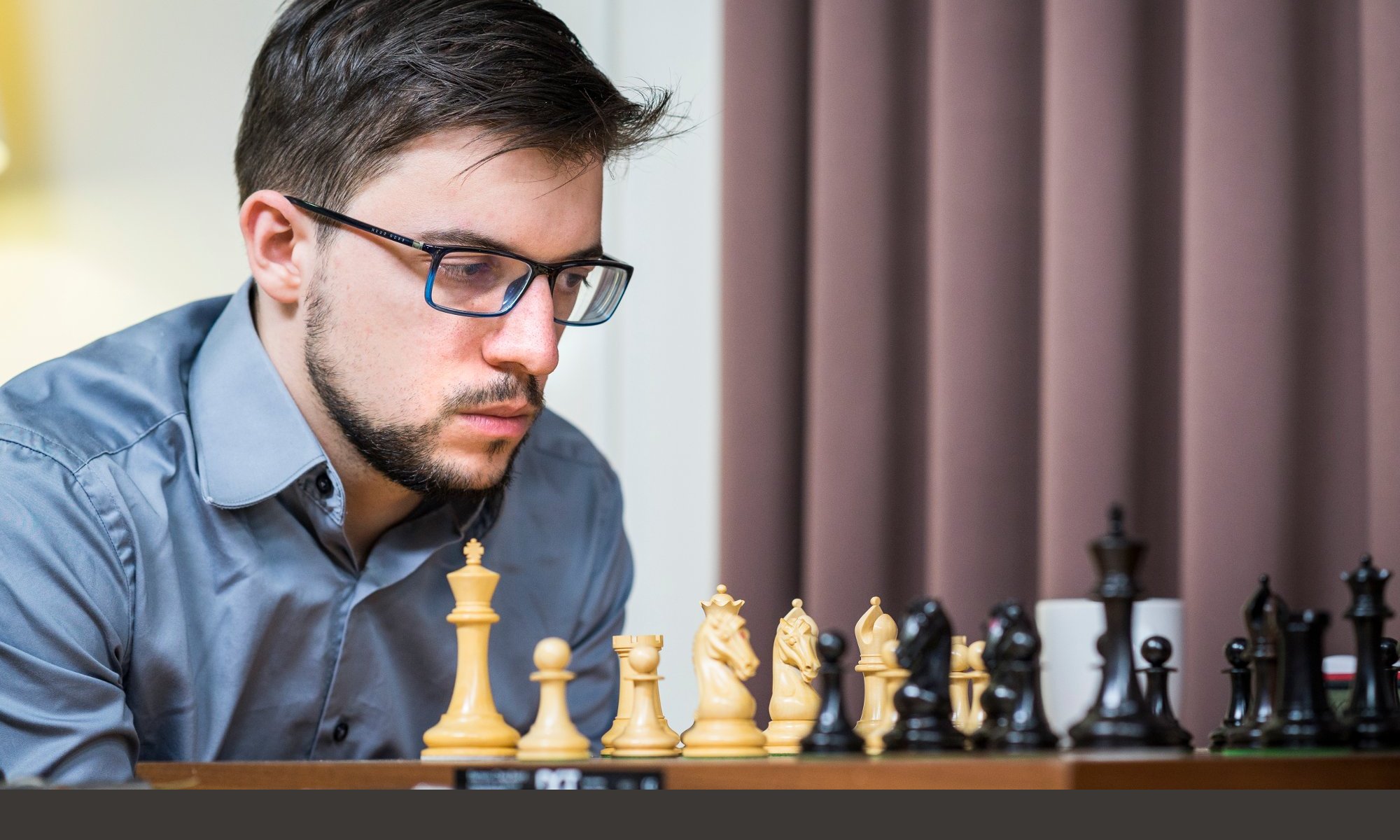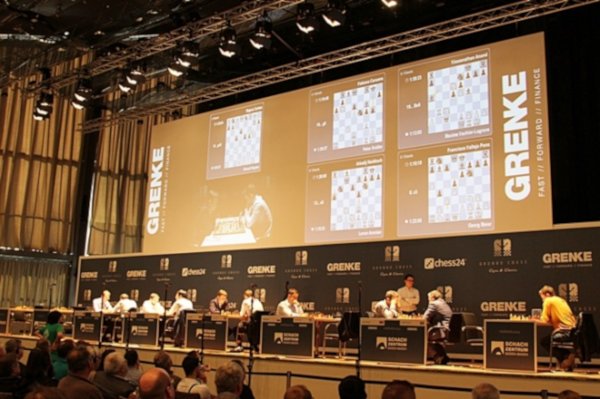Three months after I played in my last tournament (Gibraltar), the Elite season really took off on April 20, when the traditional Grenke Chess Classic organized by my German team Baden-Baden began.
As usual, the first rounds took place in Karlsrühe, alongside the gigantic Grenke Open, which gathered more than 2.000 players this year! Among them, a lot of french friends, with my trainer Etienne Bacrot and my Asnières teammate Jules Moussard as leaders. Although both unbeaten, they could never play a key role in the tournament, because of the too many draws they conceded.
The Grenke Classic offered this year a very strong line-up, leaded by Magnus Carlsen, in a state of grace those last months. With vice-world champion Caruana, as well as Anand, Aronian and myself, it is half the World Top 10 which was gathered in Germany. Three members of the Baden-Baden team also made the trip (Svidler, Naiditsch and Vallejo), and the field was completed with German players Meier and Keymer. The latter, only 14 years old, was making a noteworthy entrance in a tournament of this caliber, thanks to his victory in last year’s Open.
Round 1: Mvl – Anand (2774) 1/2
Quite a difficult introduction, as I didn’t expect Vishy to enter this heavy tactical line of the Advance Caro-Kann. So I found myself falling between two chairs – so to speak – hesitating between taking a draw already known by theory, or trying to remember all the subtleties of a line I had previously analyzed. When I fully understood that I would never remember all details, I chose the path of wisdom!
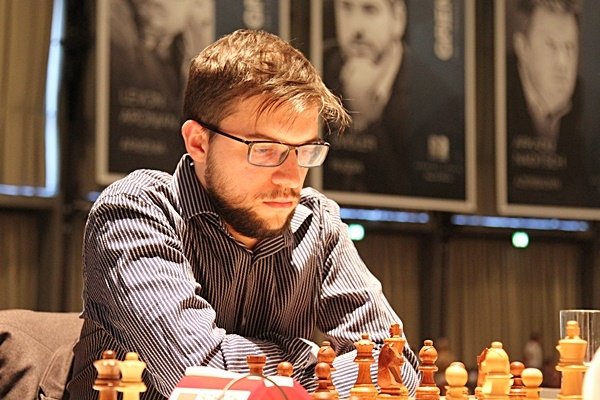
Round 2: Caruana (2819) – Mvl 1/2
I was expecting with delight a Najdorf debate, but Fabiano shied away from it, and had me wrong-footed with 2.Nc3 followed by 4.Qxd4! I had the feeling I equalized though, but the reality is that a few good moves gave him the edge, in particular 19.Kd1! in the following position.
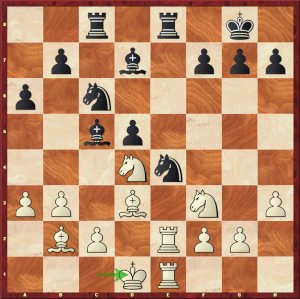
After 19…f6 20.Nxc6 Bxc6 21.Nd4 Bd7?!, he could have won a pawn with 22.c4! (instead of 22.f3), as what I had in mind 22…Bf8 23.cxd5 Nc3+? doesn’t work: 24.Bxc3 Rxc3 25.Bc4! and the trapped Rook will cost the exchange. Once the fright was gone, I could defend the position without much difficulty.
Round 3: Mvl – Naiditsch (2695) 1/2
It is known that I remain one of the few Elite players to keep on fighting the Berlin Wall! The fact is that the opening went well, and I got an edge. My problem was that I had a lot of options, and I probably didn’t choose the best one, at least from a practical point of view.
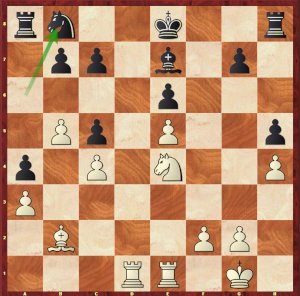
24.f4 Rf8 (otherwise 25.f5!) 25.Nf6+!? is spectacular, but the main drawback of the line is that it gives black a series of forced moves. Probably more efficient was 24.Re3!, which I rejected because of the counterplay on c4 with …Nd7-b6. But actually, after 24…Nd7, the manoeuver 25.Rg3! Rh7 26.Rgd3 Nb6 27.Bc1! gives an overwhelming advantage. The threat is 28.Bg5, and if 27…Nxc4 28.Rd7!. In the game, after 25…gxf6 26.exf6 Bd6 (26…Rxf6? 27.Bxf6 Bxf6 28.Rxe6+ Kf7 29.Rxf6+! Kxf6 30.Rd8 is decisive), I still had the option 27.Rd5! to keep an advantage. But I didn’t see this move and I chose 27.Rxe6+?!, after which I have no more than a draw: 27…Kf7 28.Rde1 (28.Rdxd6 cxd6 29.Re7+ Kg6 30.Kf2 Rd8 31.Rg7+ Kf5 32.Kf3 Nd7 33.Rg5+ Ke6 34.f5+ Kf7 35.Rg7+ Kf8 remains very messy) 28…Rd8 29.g4!? hxg4 30.h5 Nd7 31.Re7+ Bxe7 32.Rxe7+ Kg8 and I will have to content myself with a perpetual.
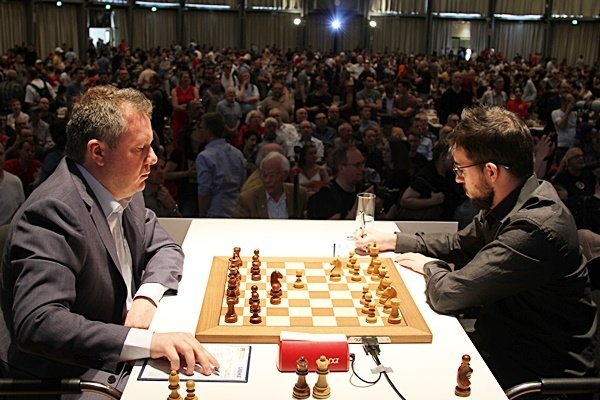
Round 4 : Meier (2628) – Mvl 0-1
I equalized easily against the try 5.h3 in the Grunfeld. After a few midllegame inaccuracies from both of us, in particular when Meier was heavily low on time, we landed after move 40 in an endgame which is probably a draw, but remains unpleasant to defend for white.
However, he did it rather well, and got a clearly drawn position afew moves later. By inertia, I kept on trying, with the vague hope of testing him in the R+N vs R endame if I had an opportunity. That’s precisely when he began to make some rather strange decisions, until the culminating point in the following position:
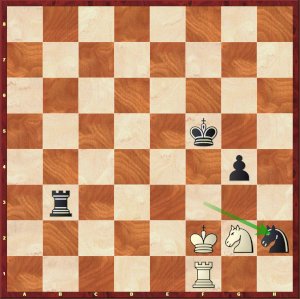
Here, I had seen that he had to play 71.Rd1!, in order to keep the King on the second rank, for instance 71…g3+ 72.Ke2 Rb2+ 73.Rd2!. But he played 71.Ra1?, and after 71…g3+ 72.Kg1 Nf3+ 73.Kh1 Rb2, I felt that I should be winning. But I couldn’t find exactly how, so I groped for an idea, before to find the nice zugzwang of the game.
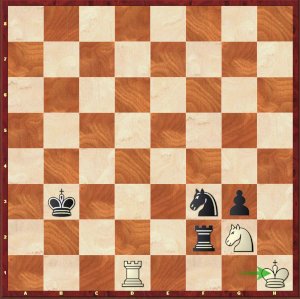
I travelled with my King from the Kingside to b3. Here, Meier had to find the only move 82.Kh1!, in order to get the same position than in the game, but with black on the move! For instance 82…Kb2 83.Re1 Nf3 84.Rd1. In this nice position of mutual zugzwang, I would have had to admit that the King’s journey was useless, and tried to find the winning plan with the King on the Kingside. Meier made things much easier for me with 82.Rd1? Nf3+ 83.Kh1 Kb2! and being on the move, white has nothing else than 84.Rg1, giving the exchange. But beware! It is not yet so trivial after 84…Nxg1 85.Kxg1,because black’s King is far away. But I I had foreseen a clinical line, which gives the g pawn away, but isolates the white’s Knight from the King. 85…Kc3 86.Ne3 Rd3 87.Nf1 Ke2! 88.Nxg3+ Kf3 89.Nf5 Rd2 90.Nh4+ Kg3 91.Nf5+ Kg4 92.Ne3+ Kf3 93.Nf5 Rd5 94.Ne7 Rc5 0-1.
Round 5: Mvl – Aronian (2763) 1/2
Levon uncorked a new idea of closing the center in an Anti-Marschall position we had already discussed a number of times. Maybe I shouldn’t have agreed to a draw so quickly, but all the possible plans to play for the advantage involved a Kingside expansion, which on the board, looked quite risky to me.
After this game, we had a rest day which was used to make the (short) trip between the tumultuous playing hall in Karlsrühe, and the intimacy of the one in Baden-Baden!
After this game, we had a rest day which was used to make the (short) trip between the tumultuous playing hall in Karlsrühe, and the intimacy of the one in Baden-Baden!
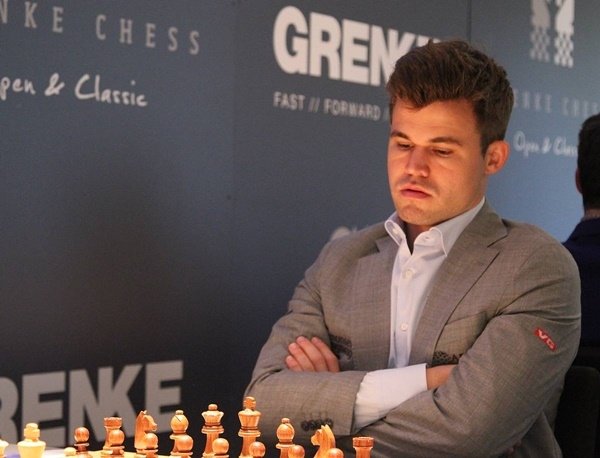
Round 6: Svidler (2735) – Mvl 1/2
I fairly easily equalized against the English, and Peter took a risk when he declined to exchange Queens on move 12. So I tried to play against his offside Queen on h3.
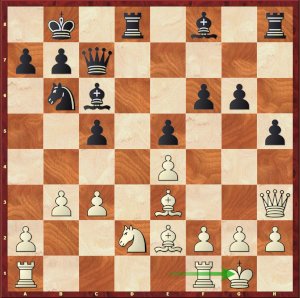
Unfortunately, here I made the wrong decision of exchanging black squared Bishops by 18…Bh6?!, as I didn’t see any follow-up for the attack. I was not sure to be quicker in case of mutual attacks on opposite sides, a4-a5 being very fast for him, while his Queen might reenter the game if the position opens up. But the computer refutes me , and argues that the simple 18…Be7, as well as the sharp 18…f5!? 19.exf5 Nd5, would both have given me a clear edge! In the game, after 19.Bxh6 Rxh6 20.Qe3 Rh7 21.Rfd1 Rhd7 22.Nf1 and the exchange of all four Rooks, the position quickly simplified towards a draw.
Round 7: Mvl – Vallejo (2693) 1/2
A long game full of manoeuvers, typical of the Advance French. The problem with this kind of position is that you always feel fine, with a space advantage, but it’s in fact never that simple. I tried to organize my pieces so as to be able to sac a piece on the Kingside, but I never found a way to do so in a convincing manner.
Round 8: Mvl – Keymer (2516) 1-0
The young German is a Sicilian Najdorf fan, but I chose to transpose the fight right into the middlegame with 2.c3. In a rather simple and equal position, he opted for the radical 17…b5?!, whose idea is to get control of d5, even though at the cost of time. He had no obligation to do so though.
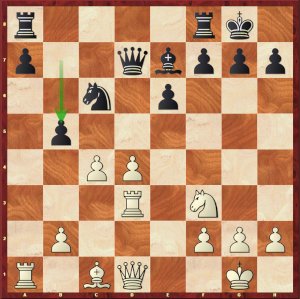
After 18.cxb5 Nb4 19.Ne5 Qxb5 20.Rh3, I was able to play my Rook all along the third rank, alternating threats on both wings. I ultimately forced the weakening …f5. Maybe the position was still within equalizing margin for him, but it’s really tough to defend in a practical game! He had a last chance in the following position, however with very few time left for his remaining 4 moves.
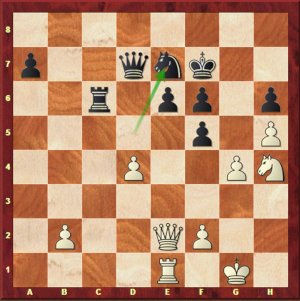
Here, objectively best was probably 37.gxf5 exf5 and white keeps an edge, but I still played 37.Qe3, as I felt that his idea was to bring the Rook to g8 via c8, and I had anticipated that it was wrong! Indeed, after 37…Rc8? 38.gxf5 Rg8+ 39.Kh2 Nxf5 40.Nxf5 exf5, I could display a nice and winning stairway manoeuver; 41.Qb3+ Kf8 42.Qb4+ Kf7 43.Qc4+ Kf8 44.Qc5+ Kf7, and now 45.Ra1! Ra8 46.Ra6! is lethal as black can’t move anymore (1-0, 49 moves). However, after 37.Qe3, he still had the loophole 37…fxg4 38.Qxh6 g3!, and the position remains very unclear after 39.Qh7+ Ke8 40.Nf3.
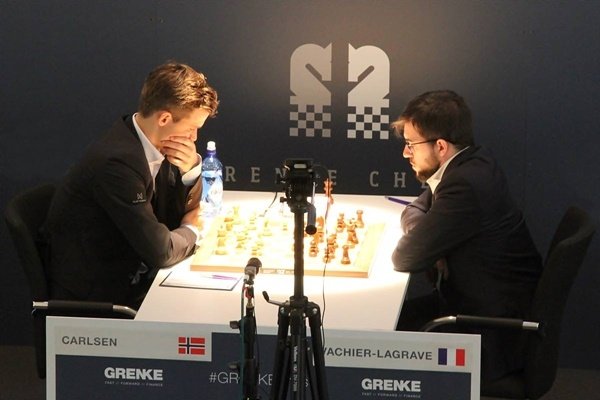
Round 9: Carlsen (2845) – Mvl 1-0
A very difficult game against an amazing Carlsen, who was almost assured of the tournament victory before the last round. On the board, I decided not to play my usual systems against the English, opting for the flexible variation with …d6 and …Ff5, while avoiding his prep on the way.
Nevertheless, I was a bit surprised by his move 9.Be3, with the clear intention of playing d4 in good circumstances.
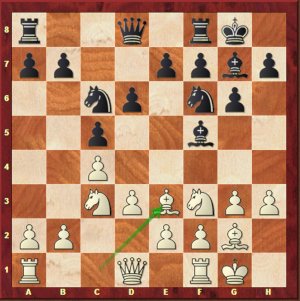
But there was no reason to overreact with …a6-…b5 as I did. I had various other « normal » options at this moment; for example 9…a6 10.Qd2 Rb8, with the idea …b5, but without sacrificing the pawn! But having said A, I went on with my idea and said B, pushing 10…b5? immediately. I thought I had compensation after 11.cxb5 axb5 12.Nxb5 Qa5, but I quickly realized the truth, ie. that it was not to be! Nevertheless, I could ask Magnus tactical questions, and he had to find a transposition in a Queen’s endgame with a pawn up.
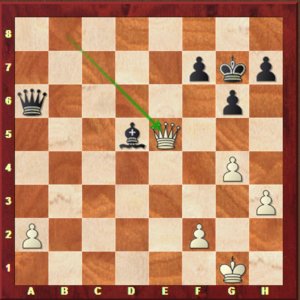
Here, I could have offered a much tougher reistance, had I played 34…Kg8 35.Qxd5 Qa3, and white still has to demonstrate how he wins this. Instead, I wanted to be active with 34…f6? 35.Qxd5 h5, only facilitating white’s task after 36.gxh5 gxh5 37.Qd7+ Kg6 38.a4 Qe2 39.Qd5! and everything is under control (1-0, 44 moves).
Thanks to this final win, Carlsen won the tournament with the staggering score of 7.5/9. There’s nothing to add; just applaud…
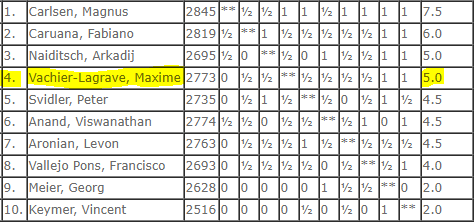
As for me, I felt I was not really in great shape in this tournament, and I didn’t play any particularly inspiring game. The result is more or less ok, not the quality of the games.
From now on, the calendar is speeding up, as I will fly on Monday, May 6 to Abidjan (Ivory Cost), where the first tournament of the Grand Chess Tour 2019 will take place, May 8-12.
It is not so frequent that Maxime is approached in Paris streets, in particular in the Jardin du Luxembourg near his flat, where you can often see him walking or jogging. Well, this is not so frequent :), but it gives chess amateurs who recognize him the opportunity to exchange a few words, and to encourage him for his forthcoming competitions.

Maxime’s games :
